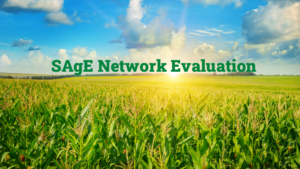Evaluation: Measuring What We Do

Dr. Erin King, Evaluation Specialist
Because SAgE and the other three Farm and Ranch Stress Network regions are funded by the USDA, regular reporting is required to account for how those funds are used and the effectiveness and impact of the funded projects.
For the southern region, that evaluation is conducted by Dr. Erin King, whose qualifications include a PhD in Agricultural Sciences from Mississippi State University, work with the CDC as a member of the evaluation team on the Mississippi High Obesity Multi-Site Program, and an evident passion for the work of evaluation.
Dr. King recently gave a presentation to SAgE’s funded partners about what evaluation is, what it isn’t, and why it’s important.
Evaluation vs. Research
Both evaluation and research use data collection tools like surveys, interviews, and focus groups, but their purposes are distinct. Research generates new knowledge and answers specific questions, whereas evaluation, in the context of SAgE, uses those tools to assess the success of a program and to make a determination about whether it should continue.
Defining Evaluation
Citing Rossi, Lipsey, and Henry’s (2019) book Evaluation: A Systematic Approach, Dr. King defines evaluation as “Evaluation is the systematic assessment of programs designed to improve social conditions and our individual and collective wellbeing.” Specifically, in the case of SAgE’s funded programs, evaluation monitors those programs to identify gaps and needs, program successes, and areas of improvement.
Gathering that information and putting it in the form of program evaluation is an important part of the reporting to the USDA for continued funding of farm stress work across our region.
“A collection of quarterly reports, standout stories, impact statements, and regional qualitative and quantitative evaluations will be used to report to partners, community members, and USDA,” Dr. King says.

Best Practices
There are a number of best practices to consider when conducting evaluation, which Dr. King shared with the partners to ensure that all parties work toward meaningful evaluation.
- Involve key stakeholders: this allows for the identification and capture of key pieces of information.
- Acknowledge levels of power: involving the community in all stages of documentation empowers all stakeholders.
- Use diverse data collection methods: some methods are more appropriate than others for different questions and audiences.
- Have an action component: SMART (specific, measurable, achievable, relevant, and time-specific) goals give participants a sense of purpose in terms of the data being collected.
- Build evaluation capacity: increasing the knowledge and skills of individuals leads to a better quality of evaluation.
- Documentation: Reporting and keeping a record of the evaluation process encourages accountability.
Why Is It Important?
Evaluation provides accountability and transparency to the funding organizations and to partners. It also provides documentation for work that should be showcased through flyers, presentations, and other formal and non-formal outlets. This provides a greater opportunity for collaboration in increasing positive and healthy outcomes across the nation.
